Liquids are separated from solids in two common manners: settling or squeezing. The primary device used for the settling mechanism is the centrifuge, and the primary devise used for the squeezing mechanism is the screw press.
Settling results from the action of gravity. Solids can be separated from liquids by letting the mixture sit in a settling pond, tank, Imhoff cone, etc. The effect of gravity can be accelerated and multiplied by spinning the fluid in a centrifuge. Centrifuges are used in a very wide range of industrial applications. In fact, they are far more common than screw presses.
Materials can be squeezed by forcing them against a screen or other filter media. Old fashioned wine presses, dating back to Roman times, are a familiar example: grapes are put over a screen that is fastened at the bottom of a vertical cylinder. A piston is forced down on the grapes, and the juice is expelled through the holes in the screen.
This mechanism has some disadvantages, the principal of which is that the pressing is done in batches, rather than in a continuous flow. Another disadvantage is that a thick cake can form at the bottom, against the screen. It is difficult for fluid at the top, next to the piston, to flow through this cake and through the screen.
(Incidentally, the fibrous solids separated by modern screw presses are referred to as press cake. This term dates back to the cake-shaped plug formed in piston-type presses of the 18th century.)
The modern screw press overcomes these disadvantages by having the screw surrounded by a screened surface. In other words, the cylinder walls are made into a screened surface. And, instead of a piston, the material is conveyed toward the discharge by a helicoid screw.
The best known form of a helicoid screw is a screw conveyor. Archimedes gets credit for having invented the screw conveyor. It consists of a shaft about which is wound a spiral steel plate, much like a cork screw. The screw conveyor is supported in a trough, and material is admitted to one end of the trough. When the screw is turned, the material is moved to the other end of the trough.
This mechanism is used in a range of screw presses. Some screw presses have no openings in the barrels that surround the screw. Thus the mechanism does not separate liquids from solids. The best known example is a plastic injection molding machine: pellets of plastic are admitted at one end; the barrel surrounding the screw is heated; and molted plastic discharges at the other end and is pushed into the injection molding die. Another such press is the cooker-extruder which is used to produce pretzels and other snack foods. Flavored bakery dough is admitted at one end of the screw and cooked snack foods are extruded through the other end.
Other screw presses fall into two categories: those which remove free water from fibrous material, and those known as Expellers®. Oil Expellers® are screw presses which exert extremely high pressures. They are used to squeeze the fat in soybeans, peanuts, sunflower seeds, canola (rape seed) and other oil seeds. The internal pressure is so intense that the fat in these seeds is converted into liquid oil which flows through the openings in the screen cage which surrounds the screw.
The other screw presses, which remove free liquid from material, find an extremely wide range of applications. They are used extensively in the pulp and paper industry to separate water from cellulose fiber. They are also used in the production of food ingredients where an alcohol solution must be squeezed from foods such as soybean protein, pectin, and Xanthan gum. More mundane applications call for separating water from waste streams at food processing factories. In many cases these wastes are converted into animal feeds. Examples include orange peel from orange juice production facilities; sugar beet pulp and trash from sugar beet mills; and spent brewer’s grain from breweries. A growing use of screw presses in is dewatering dairy and hog manure as part of nutrient management programs.
The most widely used screw press of this type is the interrupted flight design. Patented in the year 1900 by Valerius Anderson, the flights on the screws of these presses have interruptions which minimize co-rotation. Compression is achieved by using graduated pitch compression stages, sometimes combined by tapering the diameter of the shaft of the screw so as to force material against the surrounding screen.
Final press cake moisture is controlled by a discharge cone (or door), which is actuated by an air cylinder. This provides easy adjustment of the dewatering. Options include both perforated and wedgewire (slotted) screens, a rotating cone, hard surfacing on the screw, and supplemental screen surface in the inlet hopper and on the face of the cone. Standard construction is stainless steel, with a carbon steel bed frame on the larger machines.
In general, larger presses use a foot mounted gearbox, while smaller ones use a hollow-shaft gearbox. Today almost all presses are driven by electric motors. Hydraulic motor drives were popular in the past, but they have lost favor with the advent of reliable and low cost variable frequency drives (inverter VFD’s).
Dilute materials can be pumped directly into the screw press. Sometimes pre-thickening improves performance. Typically this is done with a static (sidehill) screen, rotating drum screen, gravity table or even a belt press.
Vapor-tight presses are a specialty. These are used in the production of SPC (soybean protein concentrate), citrus and apple pectin, Xanthan gum, and bioresin.
Twin screw presses feature two overlapping compression screws. These are more complicated mechanically because the screws must remain synchronized. Such presses feature very positive displacement, so they are used on slippery materials such as shrimp waste. At the same time they feature internal shredding action, so they are used on fibrous material such as corn husk.
All screw presses today are built with the screws in a horizontal configuration. Through the 1800’s up until the 1950’s vertical designs were popular; however, these are no longer being manufactured.
Laboratory and pilot plant models are popular.
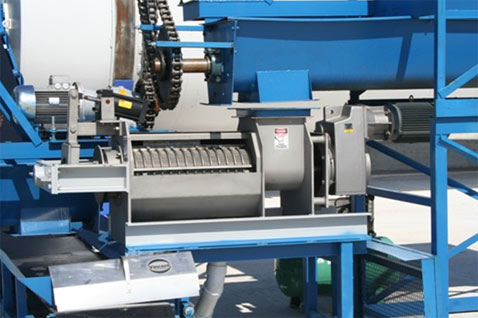 | 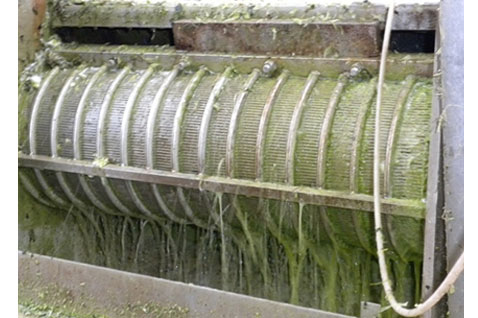 |
SMALL PRESS, NO SCREEN COVER | PRESS LIQUOR FROM SCREEN |
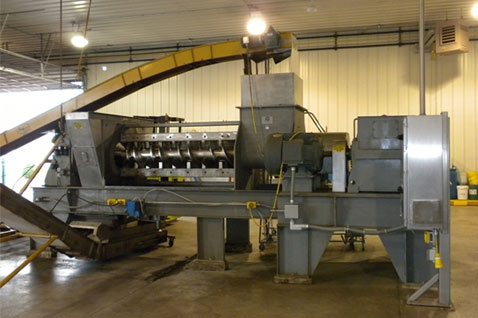 | 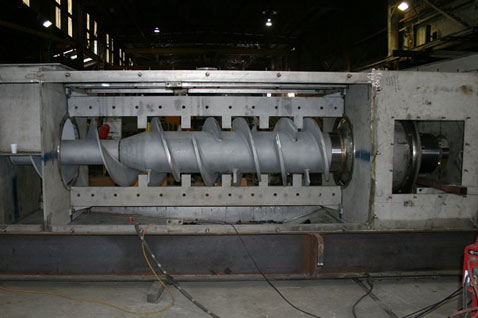 |
ALFALFA PRESS, SCREEN REMOVED | PRESS WITH SCREENS REMOVED |
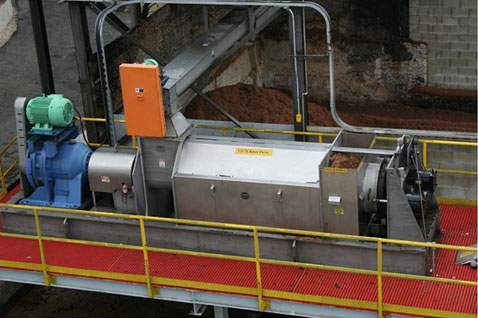 | 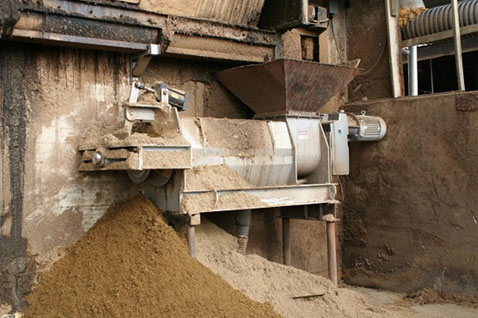 |
FOOT MOUNTED GEARBOX DESIGN | PRESS CAKE DISCHARGE |
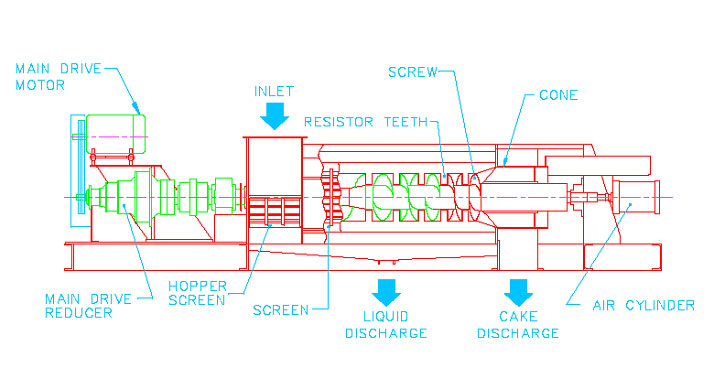 | |
Photos and drawings provided by Vincent Corporation.
